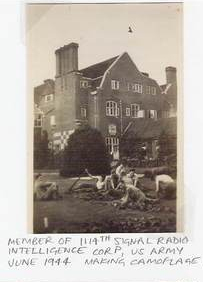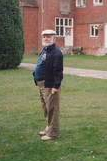
 114th Signal
Radio Intelligence Company
114th Signal
Radio Intelligence Company
12th Army Group
Shoulder Patches Left to Right: Army Service Forces, Patch Created by Disney Cartoonist (Unknown if Used, Click for Larger Format), 12th Army Group)
Campaigns
Northern France, Rhineland Ardennes-Alsace (Battle of the Bulge), and Central Europe
Occupation of Germany from 2 May to 27 December, 1945.
Chronology
1942
April 26: Constituted in the Army of the United States at Camp Crowder, Missouri
July 13: Activated 13 July 1942 at Camp Crowder, Missouri.(Source:ARMY SIGINT UNIT LINEAGES - ASA Era and Prior).
December 14: Walt Disney Productions creates an insignia. Unknown if it was ever worn.PDF with letter from Disney Productions and the design
Northern France, Rhineland Ardennes-Alsace (Battle of the Bulge), and Central Europe
Occupation of Germany from 2 May to 27 December, 1945.
Chronology
1942
April 26: Constituted in the Army of the United States at Camp Crowder, Missouri
July 13: Activated 13 July 1942 at Camp Crowder, Missouri.(Source:ARMY SIGINT UNIT LINEAGES - ASA Era and Prior).
December 14: Walt Disney Productions creates an insignia. Unknown if it was ever worn.PDF with letter from Disney Productions and the design
| 1944 At Avon Tyrrell House |
 Caption: Member of the 114th Signal Radio Intelligence Corp. (sic) U.S. Army June 1944 making camouflage. Possibly from the collection of 114th veteran Martin Byrnes. Source: Avon Tyrrell Outdoor Activity Centre |
 Direction finding Undated photo found on Pinerest |
| Personnel | |
Martin Bynres |
|
| Martin Bynres during his
1994 visit to the site of his service at Avon Tyrrell House |
|
| Jay
Crawford von Werlhof |
|
| Introduction: Honoring
the Life of Jay Crawford von Werlhof by Russel L.
Kaldenberg On page 2. author Russel L. Kaldenberg writes: "Much of the time he (Jay Crawford von Werlhof) was behind enemy lines. He was involved in the ferocious fighting during the Battle fo the Bulge." Russel L. Kaldenberg's background is in archeology and not WWII history, he may have made a good faith misinterpretation of exactly where Jay Crawford von Werlhof and the 114th served in relation to the front line and exactly what was their intelligence work. Jay Crawford von Werlhof and the 114th were not far from the front lines of the Battle of the Bulge, perhaps as close as the city of Luxembourg. Jay Crawford von Werlhof and the 114th took part in the "ferocious fighting" of the Battle of the Bulge by by intercepting Nazi radio traffic and assisting in its decoding, translation, and analysis then preparing reports on it that could be immediately used to make battlefield decisions. That probably meant the men of the 114th were working 24/7 along with intelligence units around the world. That must have been extremely stressful and fatiguing. They knew the lives of others depended on their work. Jay Crawford von Werlhof and the 114th knew they were at higher personal risk than at any other time of the war. They probably had their sidearms and rifles. Their base was probably secured with extra military police and combat units to guard against the Nazi special operation units that had infiltrated Allied lines in the first day of the Battle of the Bulge. BIographer Russel L. Kaldenberg accurately describes that in his last sentence about Jay Crawford von Werlhof WWII service. Decision making and Cognitive Analysis Track: A Historic Failure in the Social Domain by Paul H. Van Doren Sgt. Werlhof's is quote on pages 19 and 20. Sgt. Werlhof and the 114th provided accurate intelligence. The failures are of those above them. |
|
Successor Unit: 302d Military Intelligence Battalion
For more unit information:
Reading the Enemy's Mail: Origins and Development of U.S. Army Tactical Radio Intelligence in World War II, European Theater of Operations by Jeffrey S. Harley, Maj, USA
Electronic Warfare in WWII by
Maj. Richard Ricardelli
The Origination and Evolution of Radio Traffic Analysis in World War II, page 11
Sources:
The Origination and Evolution of Radio Traffic Analysis in World War II, page 11
Sources:
- Campaigns: ARMY SIGINT UNIT LINEAGES - ASA Era and Prior).
- Disney Insignia:
George Sanford, 3253d veterans sent it to SFC Robert D
Wiltzius HHD, 303rd Military Intelligence Battalion who sent
it to the Unofficial
Archive of the U.S. Army Signal Corps in Europe in
WWII